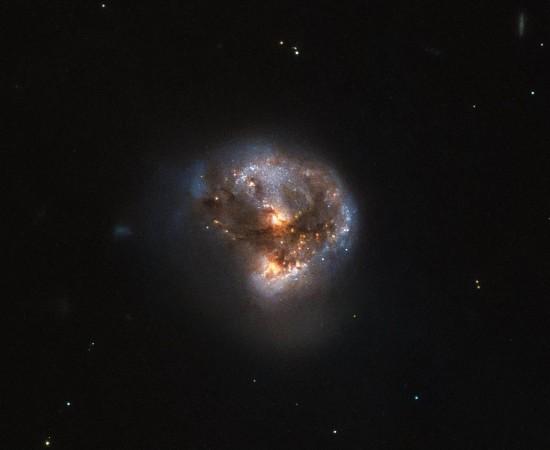
NASA's Hubble Space Telescope has discovered a galaxy dubbed IRAS 16399-0937 -- located around 370 million light years away from Earth. The galaxy is found to be a home for megamaser, which are microwave radiation-emitting galaxies.
Also Read: Top Space News 2016: Discoveries, theories and mysteries
When compared to masers found in other galaxies, megamasers are 100 million times more luminous. The transformation of galaxies to masers and megamasers takes place when intense energy is radiated by them, which is microwave in this case.
The entire galaxy is found to discharges microwave emission instead of visible light, a NASA statement revealed.
Megamaser can be referred to as a process in which some components of a galaxy, such as gas clouds are in the right condition to emit severe energy, which is microwave in this case.
The galaxy's energetic nature is portrayed by the image taken by Hubble Space Telescope, which is snapped across a range of wavelength. The photograph was captured with the help of Near Infrared Camera and Multi-Object Spectrometer (NICMOS) and Advanced Camera for Surveys (ACS).
Close analysis helped researchers in finding that the galaxy hosts a double nucleus which possessed separated cores and appeared to be undergoing the process of merging. These nuclei were dubbed IRAS 16399N and IRAS 16399S, where N and S defined the northern and southern parts which were situated at a distance of 11,000 light years.
These nuclei were found interacting; they were present deep within the swirl of cosmic dust and gas, and provided the galaxy with a distinctive and unique shape.
The newly-discovered nuclei were different from each other. The appearance of the IRAS 16399S nucleus was similar to a starburst region where star formations take place at a fast rate.
Whereas the other nucleus, IRAS 16399N, is something called LINER nucleus (Low Ionization Nuclear Emission Region), which is a region where the emission mostly originate from neutral atoms or weakly-ionised atoms of specific gases. Also, this nucleus habitats a black hole whose mass is around 100 million times than that of the Sun, a NASA statement revealed.









